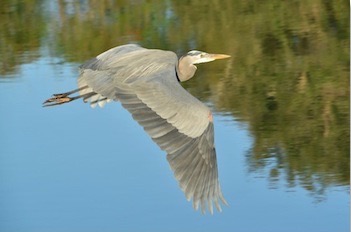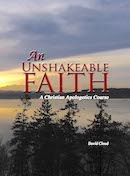866-295-4143, fbns@wayoflife.org

Great Blue Heron - (photo by David W. Cloud)
The Great Blue Heron (Ardea herodias) is a large, majestic wading bird that lives near the shores of lakes and wetlands, in both fresh and salt water habitats, over most of North and Central America and the Caribbean. Some of the birds migrate to South America in winter. It is the most common and largest of the North American herons.
Its popular name is derived from the blue-gray coloring of its wings as they cover its body when it is standing. Its head is white, and the adult has a plume of feathers that form dark blue stripes over the eyes and extend over the back of its head. The neck is light gray in the back and white in the front. Its long, sharp beak is yellow; its thighs are brown; its legs are greenish gray but become orange during breeding season; and its feet are yellow or orange. The long wings are two toned, with the feathers toward the front being light gray and the ones toward the back being darker blue-gray. Females have the same appearance as males, but are smaller.
The Little Blue Heron is smaller and is grayish blue all over, including its neck, head, bill, and legs.
A white edition, sometimes called the Great White Heron though it is the same species as the Great Blue, is found only in southern Florida and some parts of the Caribbean and is found mainly along the coasts near salt water.
The name “great” comes from its size. It has a normal standing height of about three feet and can stretch to four feet and more, with a six-foot wingspan. In spite of its size, it only weighs 5-6 pounds due to its amazingly-engineered hollow bones, a design feature shared with all flying birds.
As the heron gets airborne, it sticks it neck straight out and then tucks it back against its body in an S-shape for flight, its long legs trailing behind the body. The upper wings are two-toned: gray blue on the outer part and light-colored toward the body. It cruises majestically at 20-25 miles an hour with unique slow, deep wing beats.
The heron’s typical call is a deep, hoarse croak that sounds like fraaaahnk or braaak. In danger situations the call is a short, harsh frank frank frank taaaaaw.
When hunting, it stands statue-still waiting for prey to come within range or stalks with slow, deliberate steps, stunning or killing its prey with a thrust of its long neck. Special vertebrae allow the bird to curl its neck into an S-shape and to uncurl it with lightning fast speed. It eats fish as well as mice, insects, snakes, and other small creatures, swallowing its prey whole.
The Great Blue Heron has patches of down feathers on its chest that produce a special powder. After catching a fish, it rakes the down with a fringed claw on its middle toe to shake the powder onto its prey. This causes the fish slime to clump up so the bird can brush it off. The bird also applies the powder to the underside of its body to repel slime and oils.
The bird has good night vision via a high percentage of rod-type photoreceptors in its eyes.
The Great Blue Heron hunts alone but nests in colonies of from five to more than 100 pairs. The male and female work together to build, incubate, protect, and feed the young. The male brings the nesting materials and the female builds the nest. Herons add more material to existing nests; therefore, the age of an older heron nest can be determined by its large size.
The female sits on the eggs at night, while the male sits on them during the day. After the chicks hatch, the female watches the nest at night, while the male guards it during the day. When bringing food to the chicks, the adult usually lights a few yards from the nest and only after a few minutes does it approach the nest.
The Great Blue Heron was nearly hunted to extinction by the early 20th century because of the value of its beautiful plumage as a female hat accessory.
A group of herons is called a battery, a pose, a rookery, or a scattering.
- Receive these reports by email
- www.wayoflife.org
______________________
Sharing Policy: Much of our material is available for free, such as the hundreds of articles at the Way of Life web site. Other items we sell to help fund our expensive literature and foreign church planting ministries. Way of Life's content falls into two categories: sharable and non-sharable. Things that we encourage you to share include the audio sermons, O Timothy magazine, FBIS articles, and the free eVideos and free eBooks. You are welcome to make copies of these at your own expense and share them with friends and family. You may also post parts of reports and/or entire reports to websites, blogs, etc as long as you give proper credit (citation). A link to the original report is very much appreciated as the reports are frequently updated and/or expanded. Things we do not want copied and distributed are "Store" items like the Fundamental Baptist Digital Library, print editions of our books, electronic editions of the books that we sell, the videos that we sell, etc. The items have taken years to produce at enormous expense in time and money, and we use the income from sales to help fund the ministry. We trust that your Christian honesty will preserve the integrity of this policy. "For the scripture saith, Thou shalt not muzzle the ox that treadeth out the corn. And, The labourer is worthy of his reward" (1 Timothy 5:18). Questions? support@wayoflife.org
Goal:Distributed by Way of Life Literature Inc., the Fundamental Baptist Information Service is an e-mail posting for Bible-believing Christians. Established in 1974, Way of Life Literature is a fundamental Baptist preaching and publishing ministry based in Bethel Baptist Church, London, Ontario, of which Wilbert Unger is the founding Pastor. Brother Cloud lives in South Asia where he has been a church planting missionary since 1979. Our primary goal with the FBIS is to provide material to assist preachers in the edification and protection of the churches.
Offering: Offerings are welcome if you care to make one. If you have been helped and/or blessed by our material offerings can be mailed or made online with with Visa, Mastercard, Discover, or Paypal. For information see: www.wayoflife.org/about/makeanoffering.html.





